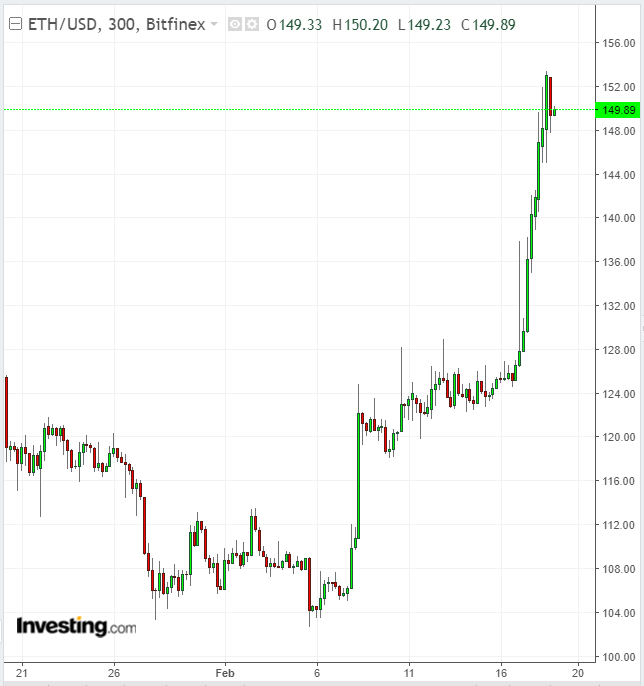The second largest cryptocurrency by market cap Ethereum (ETH) is expected to hard fork at the end of February. That's the term used when a single, blockchain-based cryptocurrency splits its protocol into dual versions. Generally this creates two separate alt-currencies going forward, both of which are automatically acquired by holders of the original token at the time of the hard fork, though that's not always the case.
Sometimes, as with this current ETH activity, a hard fork allows a cryptocurrency's developers to update the coin's infrastructure and/or its protocol (or both), so the blockchain technology doesn't degrade. As a rule, and in this instance as well, no new coins are spun off.
There are a number of technical factors behind a hard fork which investors should be aware of since it often breeds uncertainty and volatility. It can also spur prices, though not always higher.

Ethereum's hard fork, known as Constantinople, has in fact had a positive influence on the digital currency's price, at least since the start of February. ETH is up 37% since the beginning of the month.
The hard fork is set at block 7,280,000 and is expected to go live on February 27, 2019. This particular hard fork is meant to implement five improvements that address cost, speed, functionality and mining reward issues.
Originally, Ethereum core developers announced that the Constantinople hard fork would occur in mid-January, 2019, but the implementation was delayed due to security issues. A second hard fork, dubbed Petersburg, created to fix those original security issues, will happen at the same time, on the same block.
Pedro Anderson, chief operating officer of Winding Tree, a blockchain-based platform for the travel industry, notes this isn't so much a fork as an upgrade.
“We're talking about lowering gas, energy, cost and allowing for scaling with state channels. When they pull it off, it will be incredible for Ethereum and can only be positive for users.”
This type of evolution is welcome, notes André Bruckmann chief executive officer of Mycro. Constantinople will improve the network efficiency of Ethereum, he says.
"Since Petersburg only deactivates the protocol in which problems were detected this is basically just one hard fork with a security layer. However, this hard fork concerns Ethereum and I see great potential for price increases on exchanges.”
That of course is the key question: will this upgrade have a positive impact on Ethereum prices in the longer term? Fabian Frank, the tech lead of private data computation and data marketplace firm Slant, believes it will.
"The upcoming two-step upgrade seems like a simple fix after the technical issues in January. We should expect ETH to increase in price mid- term. It’s one step more to enable a bigger pool of Dapps [decentralized applications]on Ethereum.”
Evolution From PoW to PoS
Benjamin Scherrey, chief systems architect at HotNow Group, an affiliated company of Axion Ventures, likens the hard fork process to the way DNA is created when chromosomes split and pair up again. Hard forks in networks are part of the natural evolution of cryptoledger platforms, he says. They're absolutely essential in order for blockchains to ultimately demonstrate their revolutionary potential.
“The upcoming Constantinople and Petersburg forks on the Ethereum blockchain are positive developments that both shore up the value of its ledger while also revealing some existing existential challenges facing the platform as a whole.”
As part of the broader plan for Ethereum, Constantinople is also expected to be a positive step in the transition of the cryptocurrency from the comparatively more computation-intensive Proof-of-Work (PoW) protocol to the Proof-of-Stake (PoS) consensus protocol.
One of the proposed benefits of PoS, says Scherrey, would be increased fairness and transparency. As well, PoS purportedly reduces the susceptibility of a 51% attack while making the protocol significantly more efficient. In addition, switching to PoS, should enable Ethereum to better support micro-transactions that were previously too expensive and impractical with PoW, Scherrey points out.
"Due to Ethereum's present PoW consensus protocol, every token running on the Ethereum network incurs this expense and complexity which makes transaction costs for the tokens a significantly high portion of the value of the transaction.”
Moving to PoS will make transacting alternative currencies built on top of Ethereum more practical. Scherrey notes that the Petersburg fork exemplifies the dangers of the growing complexity of the Ethereum ecosystem. At the same time it raises necessary questions about whether its fundamental architecture and implementation technologies are capable of realizing Ethereum's core mission of bringing autonomous, distributed and decentralized contracts to the world in an open and transparent manner.
“The Petersburg fork is a hotfix to an issue revealed, only hours before the Constantinople fork was scheduled to go live in January, as a dangerous vulnerability in the code. Had it not been identified, certain smart contracts could have been susceptible to reentrancy-attacks, where smart contracts would be able to steal ether from other contracts, resulting in the potential eradication of a large part of the wealth on the Ethereum public network. Ethereum’s primary programming language, Solidity, has fundamental problems in its design that put Ethereum’s underlying technology at great risk.”
As for a longer-term price boost, Scherrey isn't ready to make any specific calls, but he does believe the entire asset class will benefit:
“It’s hard to say if the fork will have a critical impact on Ether’s value. Both the Constantinople and Petersburg forks carry the promise of ushering in new efficiencies that will increase the practicality and value of other utility tokens. An outcome that not only benefits Ethereum would equally serve to drive up the industry as a whole, potentially increasing the value of Bitcoin and other altcoins accordingly.”
